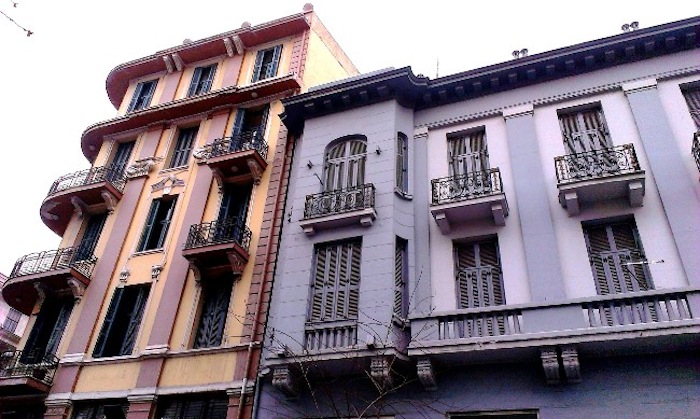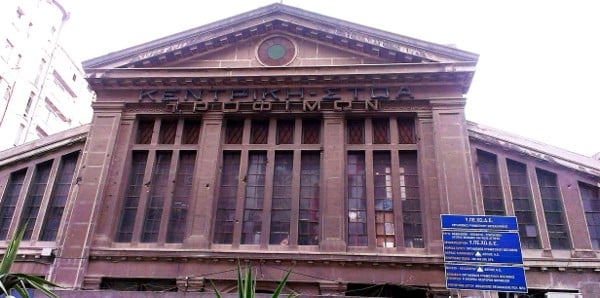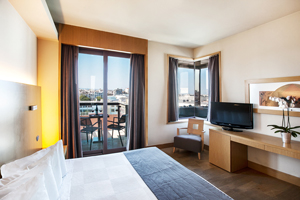By Nota Karamaouna* – One of the fundamental features of Thessaloniki – Greece’s second city, sometimes known as Salonica – since its very foundation in 315 BC was its multicultural character. The city, a key highlight on our Exploring Greece: The Archaeology, Food and Wines of Macedonia tour, was actually founded by a synoecism (the amalgamation of villages into poleis or city-states in Ancient Greece) of 26 settlements in the area. From early on, one of its most prominent communities were the Jews, who first settled there around the middle of the 2nd century B.C. and played a crucial role in the history and development of the city until the mid-20th century.
Recently, as I was revisiting the city, strolling around its great avenues and small lanes full of Roman ruins, Byzantine churches, Ottoman mosques, hammams and fountains, I was wondering about these Jewish communities and their traces in the urban fabric of Thessaloniki. Of course, I was already familiar with many stories from their past: the old looted cemetery, the infamous Black Sabbath of 1942, and the names of some great personalities, architects, businessmen and figures of the early 1900 working class movement.
As archaeologists, we are used to looking into the ground for what past remains it reveals. In contrast to that, the Jewish heritage of Thessaloniki, at least what survived the great fire of 1917, is around and above us. All you have to do is raise your head and have a look at the city’s many beautiful public buildings from the 19th and early 20th century. Their façades stand witness to the European influences that were amalgamated by the architects (many of them Jewish, as well as foreigners from various European cultures) with a strong taste of eclecticism, adopting various and diverse features and styles (Neo-classical, Neo-Gothic, Neo-Ottoman and Art Nouveau) into a harmonious urban complex. But before exploring them, we should look at the Jewish story of Thessaloniki from its beginnings.
Beginnings: Antiquity and Middle Ages
Historical sources and archaeological remains such as burial inscriptions record a Jewish presence in the city since the 2nd century BC, when the first community arrived as exiles from Alexandria (Egypt). Their presence is confirmed by the Acts of Apostles and the famous visit by St. Paul (ca AD 50) to a Jewish synagogue at Thessaloniki. Excavations in the Late Roman Jewish cemetery have revealed a vast number of burial monuments emphasizing the community’s religious and ethnic identity, which are now exhibited in the yard of the Archaeological Museum. During the Middle Ages, manuscripts and foreign travellers’ reports attest to the Jewish communities of the city and to their business activities. They also report their transfer to Constantinople/Istanbul after the fall of Thessaloniki to the Ottomans in 1430. During the 15th century, after a pogrom in Bavaria, Jewish refugees arrived and formed the Ashkenazi community. The forced removal of all Jews from the kingdom of Spain by monarchs Ferdinand and Isabella in the late 15th century led to the settlement of a large number of Sephardic-Hispanic Jews in the city, maintaining their own language, a form of Spanish known as Judeo-Spanish, until the 20th century. Their arrival marks the beginning of a long and prosperous period that ended only with the holocaust inflicted by the Nazis during the occupation of Greece in World War II.
The Golden Age: 16th century onwards
After the upheavals of persecution and emigration from Europe, Thessaloniki proved a save haven, a new centre providing a perfect location on the international trade routes between the Orient and the Occident. It is estimated that 20.000 Jewish immigrants lived in Thessaloniki by the mid-16th century. Coexisting peacefully with the other communities present (Christians and Muslims), they settled in different independent congregations near the harbour area, where they engaged especially in the crafts, particularly the production and export of textiles. Thus, the city became famous for its Jewish silk, weavers and wool dyers. As representatives of a new urban culture, Thessaloniki’s Jews also transferred their skill and knowledge to new domains. The first printing press of the Orient operated at Thessaloniki since 1512, and Thessaloniki’s Jews were at the forefront of its press until the dawn of the 20th century, exemplified by the famous family of Saadi Levi.
Looking East and Looking West: The Islamized Jews and the beginning of a new era
Meanwhile, in the 17th century, due to the decline of the Ottoman Empire and to the dubious figure of a pseudo-messiah, Sabbatai Zevi, who smartly allied with the Ottoman sultan, many Jewish families of Thessaloniki converted to Islam. Although they outwardly adopted Turkish names and Muslim observances, they continued to secretly perform their Jewish rites, due to which they are still famous as the donmedes (from Turkish dönmeh: rebel). By the turn of the 20th century, these wealthy domnedes communities (then numbering several thousand out of the ca. 80.000 Jews of Thessaloniki) constituted the most avant-garde part of town. Their activities (the famed Jewish guilds) and their contacts with European centres contributed to the spread of the western culture in Thessaloniki, its urban modernization and its fast industrial growth: Allatini’s industrial flourmills complex, the pottery and textile factories, the demolition of the ancient sea walls and creation of the new port which helped to develop trade, were all achievements of that period. Additionally, the “Alliance Israelite Universelle” established a school providing education of western standards for their youth.
A Cosmopolitan Belle Époque and its architecture: 19th/20th century
As the city expanded and modernised, becoming a powerhouse of commercial and industrial development in the Balkans, new public buildings and private mansions were built by its flourishing multicultural communities (Muslims, Christians, Jews, Donmedes and Franks). Even after the Balkan Wars (1912-1913), when Thessaloniki became part of Greece, trade continued to flourish, not least since the city became again an important centre for the soldiers of the Allied forces during World War I. Famous Jewish and Italian architects erected banks and business establishments to host the rapidly growing commercial activities.
The Stein Palace, an early 20th cerntury department store
Key examples include the the Odeon (previously the Ottoman Bank), built in 1903 and selectively adopting neo-renaissance features. The Stein Palace, the largest department store of the city and the only one to survive the 1917 fire, was sponsored by a Jewish family. In its façade, we can easily recognize the reference to the architecture of Chicago, with an emphasis on vertical axes and the consolidation of spaces.
A few metres further north is the façade of the city’s main food market – of course its name, Modiano Market, betrays its origins. It was founded in 1922 by the famous Jewish architect Eli Modiano at the heart of Thessaloniki’s commercial centre to house the main market, a function it still retains today.
The architectural style can be characterised as a peculiar form of eclecticism, using different decorative motifs and elements from classical antiquity. It was also among the first constructions of the city to use reinforced concrete, a then innovative building material. The same architect had also built, a few years earlier, the famous Villa Modiano, a vacation residence for the Jewish banker Jaco Modiano. In this excellent mansion, in the eastern part of the city, European eclecticism combines a characteristic Neo-Gothic style with art nouveau features, both in the exterior and the interior decoration (ceilings and staircases).
The end of an era: Holocaust
At the turn of the 19th/20th centuries, a great part of the main centre of Thessaloniki was bought by two of the wealthiest Jewish/donmedes families of the city (Kapantzi and Modiano) and its subsequent regeneration had a strong taste of belle époque. In 1870 Liberty Square (Plateia Elefthereias) was created near the harbour, with outstanding buildings, cafés, clubs, department stores and luxury hotels, the majority belonging to Jews. Soon this new part of the town became the central meeting point and a place frequented by the growing cosmopolitan middle class. However, this prominent square was also where the final act in the life of Thessaloniki’s Jewish communities began. It was here, on the 11th of July 1942 (Black Sabbath), that the German forces gathered ca 9000 Jewish males, subjecting them to humiliation and torturing many of them to death. One year later, 50.000 Jews were deported to the death camps in occupied Poland; by the end of 1943, no Jews were left in the city. All that was left of their rich and glamorous history was to be found in empty graves and houses. After the war, those who had survived the holocaust were organized in two small communities, while many moved abroad.
The glorious and long history of the Jews of Thessaloniki ends here, but their traces still remain. The public buildings, luxurious mansions and old factories are places that reflect Thessaloniki’s proud civic multiculturalism and form part of our collective memory of a community that contributed so remarkably to the growth and development of this city.
The history of Thessaloniki’s Jews is just one of many fascinating aspects to that beautiful city, with its uninterrupted 2300 years of urban history. For a full experience of Thessaloniki’s brilliant heritage and its many monuments ranging from the Roman period via the Byzantine era and the Ottoman age to modern times, embedded in the turbulent and magnificent history of Macedonia and its many beautiful sites and landscapes, join us on
*Nota Karamaouna is an archaeologist. This article was published originally at www.petersommer.com
Where to stay in Thessaloniki: Our Preferred Hotel Partners
Thessaloniki – Domotel Les Lazaristes *****
One of the best 5 star hotels in Thessaloniki, Domotel Les Lazaristes is a member of the luxuriy hotel-chain Domotel and welcomed its first guests on the 1st of June 2004. Domotel Les Lazaristes is a fresh hotel, full of energy, located at an area fully characterized by the arts. Its neighbouring position, nearby all major cultural centers of the city inspired its design philosophy. Its ideal geographical position offers a high quality stay in a quiet but central area of the city. It is situated at the city’s entrance, at the junction of all major highways and connects Thessaloniki with the rest of Greece and the Balkans.

Designed and built to the best specifications, the 4 star hotel aims to satisfy the highest demands of its guests, in a special environment intended to make their stay an unforgettable experience. Designed according to the latest trends of modern “minimal design” with simple lines, high quality materials such as marble, wood and glass combine perfectly to produce a feeling of luxury. Its position in the city centre is unique, 200 m from Thessaloniki Railway station, 800 from the City Port, 18 km from Makedonia Airport.
See all the latest news from Greece and the world at Greekreporter.com. Contact our newsroom to report an update or send your story, photos and videos. Follow GR on Google News and subscribe here to our daily email!








